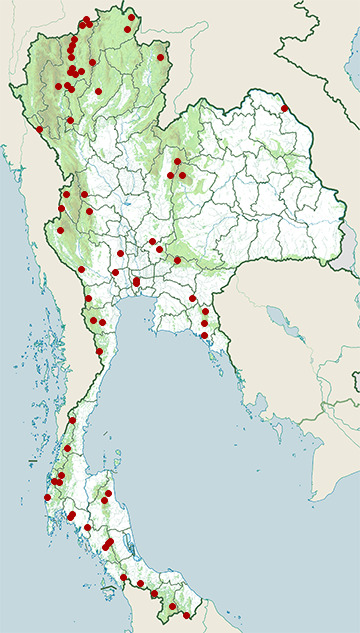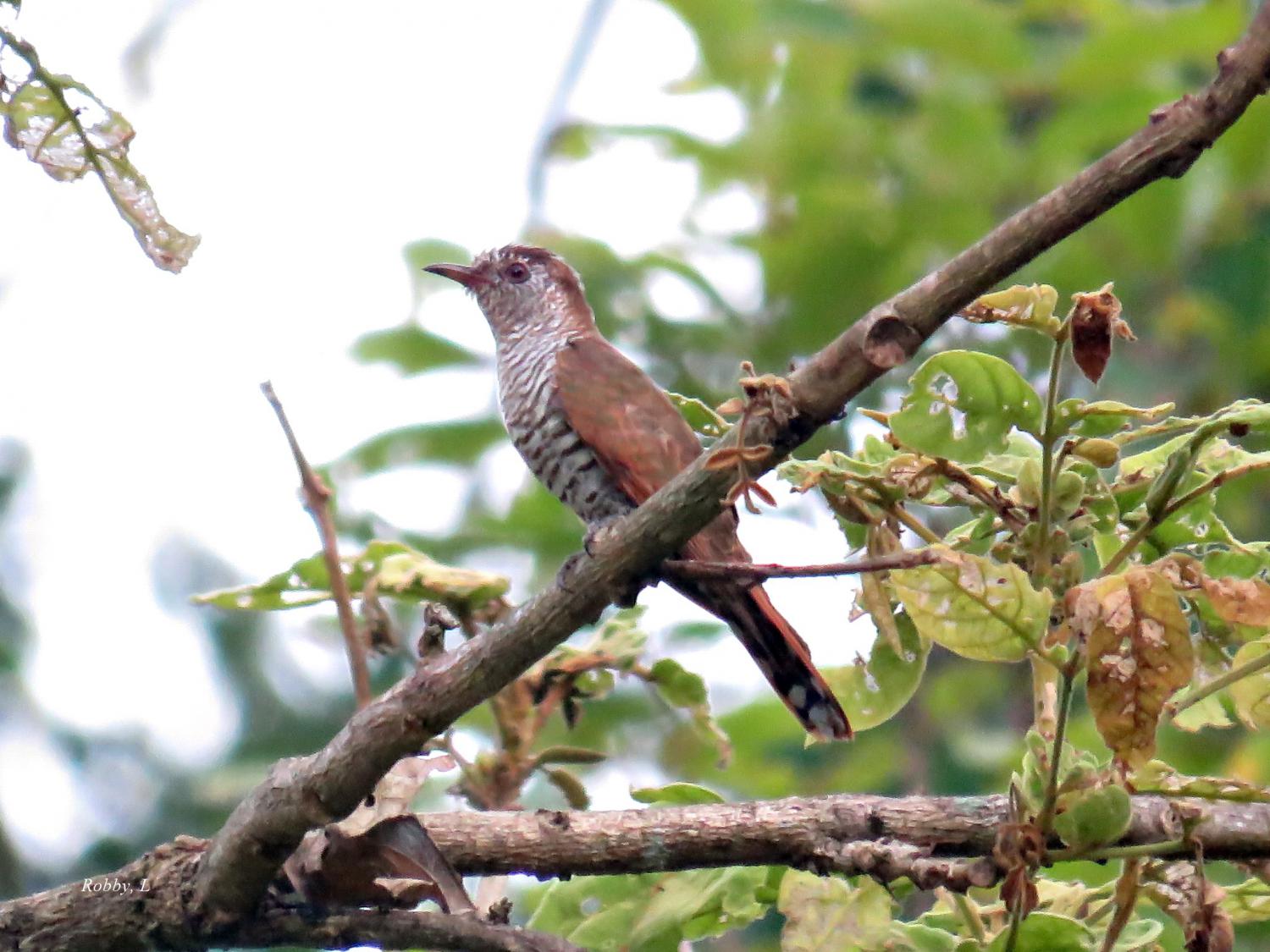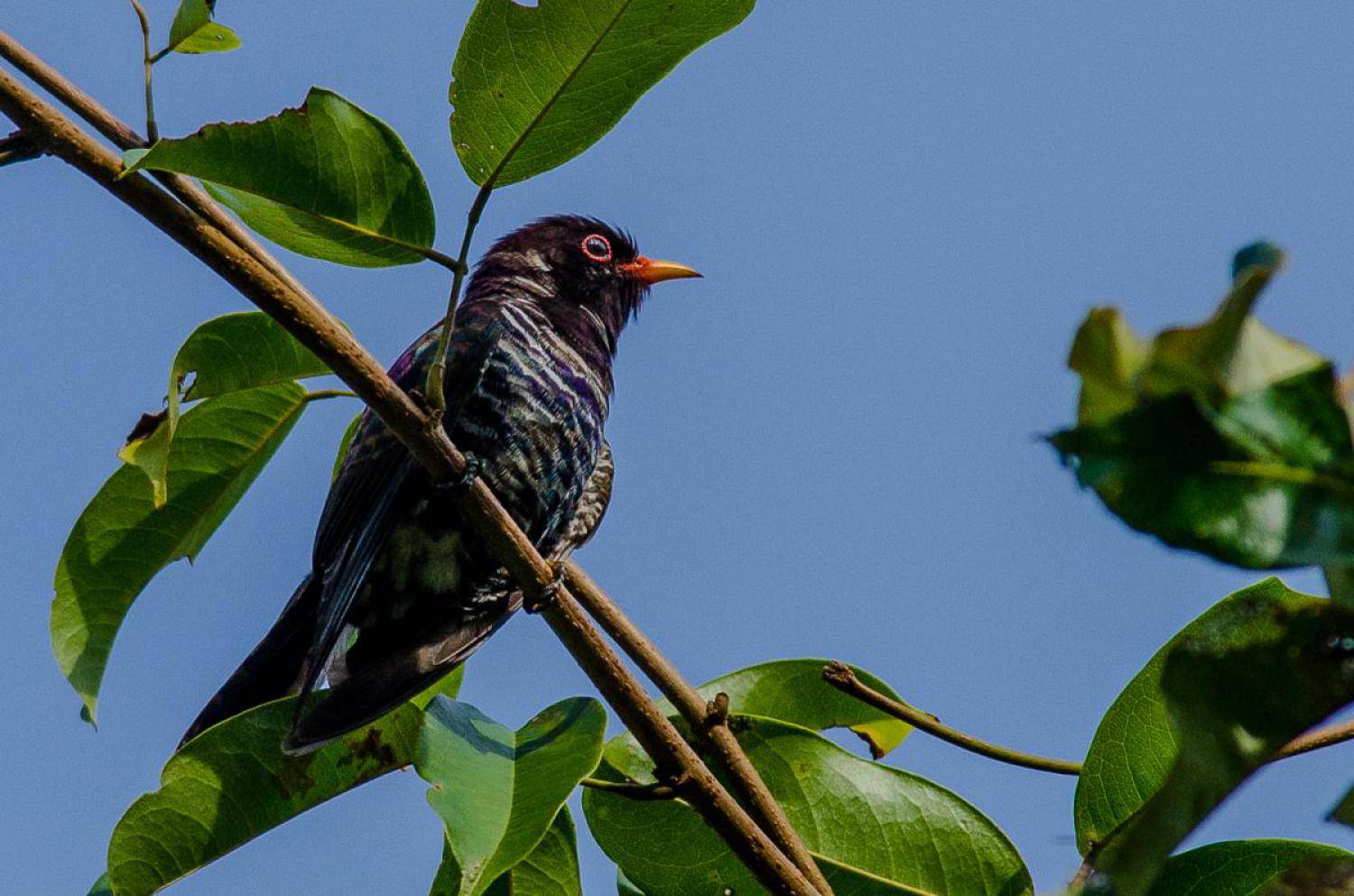Species of Thailand
Violet cuckoo
Chrysococcyx xanthorhynchus
Thomas Horsfield, 1821
In Thai: นกคัคคูสีม่วง
The violet cuckoo (Chrysococcyx xanthorhynchus) is a species of cuckoo in the family Cuculidae.
Description
The males have glossy violet feathers on the head and upper parts of the body. The blackish tail has a white tip, and barred outer feathers. The most spectacular feature is the brightly iridescent violet chin and upper breast. The belly is white with broad black, green or violet bars. Mature males also have a red eye-ring. The closely related species, C. amethystinus has a glossy blue-violet throat patch rather than reddish violet of this cuckoo.
The females have mottled, greenish-bronze upper parts and a dark brown crown. There are white markings around the eyes and sometimes on the forehead. The central tail feathers are greenish while the outer feathers are rufous with greenish bars. The outer rectrices are barred black and white. The breast is whitish with bronze-green bars and variably washed rufous markings.
Juveniles have barred rufous and greenish bronze feathers on the upper parts of the body, a bright rufous crown, rufous and mottled green or brown wings, a barred brown and rufous tail and brown-barred white under parts.
Distribution and habitat
The violet cuckoo is found from north-eastern India to Southeast Asia, Greater Sundas, Palawan and the Philippines. Southern populations are resident, while northern populations in locations such as Assam and Bangladesh appear to be migratory.
Its natural habitats are subtropical or tropical moist lowland forests and subtropical or tropical mangrove forests. It is also seen in gardens, orchards, and rubber plantations.
It occurs from lowlands up to 1500m, but mainly below 700m.
The species is reported to be uncommon throughout its range. However, because it has a wide range, the species is not considered to be threatened by the IUCN. However one source suggests that the species is threatened in areas of its range because of habitat loss.
Behaviour
Violet cuckoos are insectivorous but they will also eat fruit. They have been seen shaking hairy caterpillars to remove the stomach contents for consumption. They forage by creeping up and down branches, but they can also flycatch on the wing.
Cuckoos are brood parasites and lay their eggs in the nests of other birds. The males are active and vocal during the breeding season in order to attract mates. Once they have mated, the females become secretive as they search for appropriate nests in which to lay their eggs.
Host species recorded for the violet cuckoo are sunbirds and spiderhunters (thirteen species of the genus Arachnothera, small birds related to sunbirds). Host species often recognise adult cuckoos as a threat and chase them off, but then do not recognise that the cuckoo eggs in the nest are aliens. Cuckoo chicks are usually larger than host chicks. The chicks of many cuckoo species have been observed to throw the host chicks out of the nest, although this behaviour has not been recorded for the violet cuckoo yet.
This article uses material from Wikipedia released under the Creative Commons Attribution-Share-Alike Licence 3.0. Eventual photos shown in this page may or may not be from Wikipedia, please see the license details for photos in photo by-lines.
Category / Seasonal Status
BCST Category: Recorded in an apparently wild state within the last 50 years
BCST Seasonal status: Resident or presumed resident
Scientific classification
- Kingdom
- Animalia
- Phylum
- Chordata
- Class
- Aves
- Order
- Cuculiformes
- Family
- Cuculidae
- Genus
- Chrysococcyx
- Species
- Chrysococcyx xanthorhynchus
Common names
- Thai: นกคัคคูสีม่วง
Conservation status

Least Concern (IUCN3.1)
Photos
Please help us review the bird photos if wrong ones are used. We can be reached via our contact us page.
Range Map

- Bang Lang National Park
- Bangkok Province
- Chiang Dao District, Chiang Mai
- Chiang Dao Wildlife Sanctuary
- Chiang Khong District, Chiang Rai
- Doi Inthanon National Park
- Doi Lang
- Doi Lo District, Chiang Mai
- Doi Pha Hom Pok National Park
- Doi Phu Kha National Park
- Doi Saket District, Chiang Mai
- Doi Suthep - Pui National Park
- Hala-Bala Wildlife Sanctuary
- Huai Kha Khaeng Wildlife Sanctuary
- Kaeng Khoi District, Saraburi
- Kaeng Krachan District, Phetchaburi
- Kaeng Krachan National Park
- Kaeng Som Maew Queen Sirikit Forest Park
- Kamphaeng Saen District, Nakhon Pathom
- Khao Ang Rue Nai Wildlife Sanctuary
- Khao Banthat Wildlife Sanctuary
- Khao Chong
- Khao Khitchakut National Park
- Khao Laem National Park
- Khao Lak - Lam Ru National Park
- Khao Luang National Park
- Khao Nam Khang National Park
- Khao Nan National Park
- Khao Phanom Bencha National Park
- Khao Phra - Bang Khram Wildlife Sanctuary
- Khao Soi Dao Wildlife Sanctuary
- Khao Sok National Park
- Khao Yai National Park
- Khlong Saeng Wildlife Sanctuary
- Khun Chae National Park
- Khun Tan District, Chiang Rai
- Kui Buri National Park
- Mae Ai District, Chiang Mai
- Mae Moei National Park
- Mae Ping National Park
- Mae Rim District, Chiang Mai
- Mae Taeng District, Chiang Mai
- Mae Wong National Park
- Mueang Chiang Mai District, Chiang Mai
- Mueang Krabi District, Krabi
- Mueang Lampang District, Lampang
- Mueang Nonthaburi District, Nonthaburi
- Mueang Suphanburi District, Suphan Buri
- Nam Nao National Park
- Namtok Phlio National Park
- Pa Sang District, Lamphun
- Pha Daeng National Park
- Phato District, Chumphon
- Phu Khiao Wildlife Sanctuary
- Phu Langka National Park
- Sai Yok District, Kanchanaburi
- San Kala Khiri National Park
- Sri Phang Nga National Park
- Tat Mok National Park
- Thale Ban National Park
- Thung Yai Naresuan Wildlife Sanctuary
- Umphang Wildlife Sanctuary
- Wang Mai Forest Restoration Project
- Wat Tham Erawan Non-Hunting Area
- Yan Ta Khao District, Trang

